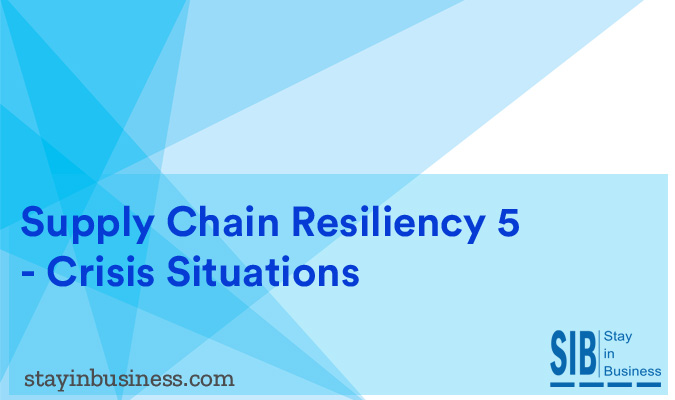
Opportunities for Growth
Over the last ten to twenty years, the world has borne the brunt of an endless stream of red alert catastrophes, both natural and manmade. While modern day supply chain networks have spread far and wide to include a large number of different and disparate entities into one consolidated network, they have also become more exposed to a vast range of risk factors. For instance, the inability to procure a specific raw material from a given location can severely impact an organization’s production at its manufacturing facility located at the opposite end of the globe. It has become imperative to redefine the goals and objectives of risk management to encompass all aspects of a supply chain network, including factors that are beyond the organization’s jurisdiction.
Crisis and emergency situations must be calibrated based on their nature, intensity and complexity so that organizations can adopt a systematic approach while designing their response strategy. Today’s supply chain systems that are powered by smart technology based systems view any risk as a structural inefficiency that is essentially intrinsic.
An exhaustive fleet of smart devices are deployed across the network to constantly monitor performance efficiency. Optimum operational standards are established. Deviations across measurement parameters such as thermal readings, inventory, and timeframes are reported. The relevant responses are triggered. Since outsourcing is a big part of virtually any business today, enterprises even involve their third party vendors while designing risk management strategies.
When disaster strikes, the availability of a high speed, robust and resilient network that stretches across the entire supply chain and not just specific segments, becomes very crucial for the organization to transition the crisis. And in a smart technology enabled supply chain, the entire network can be broken down into individual segments. Vulnerabilities of these individual segments can be scrutinized through modeling and simulation techniques. But individual segments can also be grouped in various permutations and combinations to be analyzed collectively. Thus, the resiliency of the entire supply chain network can be optimized by adopting a scenario based approach.
Smart technology is also allowing organizations to introduce more corporate social initiatives across the supply chain. For instance, the consumption of fuel, gas, electricity and water, as well as the disposal of wastes and residue can be monitored and made more efficient using smart technology enabled systems. Even the minutest inefficiency can be spotted and nipped in the bud way before it gathers momentum and turns into a full-fledged issue that slows down operations. This is possible today thanks to an internetworked system powered by real time connectivity. Addressing social and environmental concerns through a business ethos founded on transparency – something that most customers and business associates today have come to expect – has become more feasible than ever.
Being Prepared
- What is the approach to making supply chain operations more resilient?
- What is the strategy for deploying smart devices such as RFID tags and sensors for preventing potential hazards?
- How can the supply chain adopt green initiatives without compromising on its commercial obligations?
Machine Aided Approach for Handling Crisis Situations
- Sensor devices and monitors that can track goods and merchandize through the entire production life cycle
- Smart technology based solutions to ensure that goods and merchandize meet the organization’s quality parameters as they move through the supply chain
- Forecasting external and environmental conditions that might hamper operations
- Outlining workaround strategies for transport, distribution and storage
Responding to Crisis Situations through Connectivity
- Building intrinsically resilient communications infrastructure
- Robust and scalable networks with customizable recovery and restoration
- Regulating business tie ups with external vendors through policies
- Leveraging sustainable solutions across the supply chain network
Responding to Crisis Situations through Data Driven Systems
- Forecasting the types of risks that will have to be addressed regularly, based on parameters such as frequency, intensity, and risk visibility
- Assessing the monetary implications of different risks through sampling techniques
- Risk centric storage adaptability
- Strategy for designing simulated scenarios to test response and restoration procedures
- Risk mitigation through probabilistic graphical modeling
Case Study
A well established network company has a wide range of products and services that can facilitate high speed business connectivity regardless of industry or domain. In order to make systems more robust and limit the impact from catastrophic disasters, the organization designed a logistics framework that gauges the resiliency of infrastructural segments across a variety of parameters. Key entities across the supply chain network such as vendors, providers, business associates and contractors are given the responsibility of maintaining collectively established resiliency objectives within the scope of their business operations.
The risk management framework was a collaborative effort that brought together logistics experts from various industries. The result was a commonly available database of procedural recommendations. The objective was to create a mechanism for measuring risks, their business impact and deploying a contextually relevant response. This activity includes identifying backup vendors, verifying the feasibility of alternate sites and so on. A business continuity plan was leveraged across the entire supply chain.
The company was able to deploy mitigation plans in response to disasters such as tsunamis, hurricanes or cyclones and insulate mission critical operations, commercial obligations and stakeholder interests. When there was an impact at a specific location, the disruption relevant data could be quickly collected, processed and analyzed to trigger the appropriate response. This strategy was employed across the supply chain to ensure that crucial parts and raw materials remained available despite high impact catastrophes.
Disasters
See for yourself how the application works
Witness our cloud based platform’s security capabilities in action
Play around with the software and explore its features
Compare and choose a solution that’s relevant to your organization
Consult our experts and decide on a pricing mechanism
[carousel id=’1780′ items=’4′ items_desktop=’3′ margin_right=’5′ navigation=’false’] [item img_link=”https://www.stayinbusiness.com/wp-content/uploads/2016/02/Chemical-Spills-Discharges.jpg” href=”https://www.stayinbusiness.com/resource/disaster-recovery/chemical-spills-and-discharges/”][item img_link=”https://www.stayinbusiness.com/wp-content/uploads/2016/02/Riots-Public-Disturbances.jpg” href=”https://www.stayinbusiness.com/resource/disaster-recovery/riots-and-public-disturbances/”][item img_link=”https://www.stayinbusiness.com/wp-content/uploads/2016/02/Terrorism.jpg” href=”https://www.stayinbusiness.com/resource/disaster-recovery/terrorism/”] [item img_link=”https://www.stayinbusiness.com/wp-content/uploads/2016/02/worst-product-recall.jpg” href=”https://www.stayinbusiness.com/resource/disaster-recovery/product-recall/”] [/carousel]
